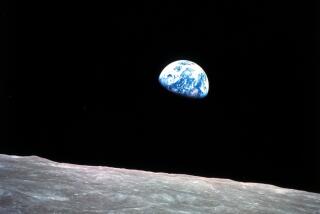Space Shuttle, Yes; Space Mountain, Oh No
- Share via
SPACE CENTER, Houston — Eileen Collins, commander of the next space shuttle mission, is eager to strap herself into a rocket ship loaded with explosive fuel and fearlessly shoot from zero to 1,000 mph in a minute flat.
Just don’t ask her to get on a roller coaster.
Collins -- the first woman to pilot a shuttle and later the first female commander -- will preside over NASA’s nail-biting return to space more than two years after the Columbia tragedy.
Known for being cool and calm, Collins already handled one of NASA’s most perilous launches, in 1999. But she doesn’t have the stomach for roller coasters. “Maybe a psychologist can go figure it out,” she said with a smile.
She’s been on roller coasters twice some 20 years ago, including Disney World’s Space Mountain -- and never again.
Even steep water slides are out. Last summer, Collins took her daughter to a water park, stood in line an hour, got to the top, looked down and declared: “I’m out of here.”
“We went back down the stairs.”
Flying in space, though, is different. “I have a certain amount of control over what we’re doing. Heck, we have a good amount of control over what we’re doing. It is a mission that I believe in that has a reward at the end. It has a purpose, and that’s the difference to me.”
This confidence is encouraging since the fate of the shuttle, perhaps of the entire space program, lies in Collins’ hands. She intends to bring the shuttle back calmly and coolly even as the craft makes its way down through the same infernally hot atmosphere that incinerated Columbia and its crew of seven.
“I have no nerves. No emotion. No pressure,” Collins said before climbing aboard a simulator at Johnson Space Center in April to practice yet another re-entry.
Her flight aboard Discovery, with six other astronauts, will be packed with the purpose that Collins craves. On Friday, NASA officials delayed the flight, which had been planned for late May, until at least July 13 to ensure safety.
The 12-day space station delivery and repair mission will be the first time that a shuttle has flown since Columbia’s catastrophic re-entry over Texas on Feb. 1, 2003. It is considered a test flight because of the new external fuel tank, revamped to prevent big pieces of foam insulation from breaking off and striking the shuttle, and the many new methods of hunting for damage. It was a chunk of foam that snapped off and ultimately brought down Columbia.
The 48-year-old former test pilot and retired Air Force colonel will fly never-before-attempted twist-and-flip maneuvers in an effort to pose the shuttle for crucial zoom-in photographs.
She will oversee three spacewalks by her crew, including one to test techniques for repairing minor damage to sample thermal tiles and panels, and a prolonged inspection of Discovery’s wings and nose using a new 50-foot boom that will be attached to the ship’s 50-foot robot arm.
If things go bad and Discovery is damaged by the inspection boom or launch debris, she may have to send her crew out to use the rudimentary, experimental repair techniques. If things go really bad and the damage is irreparable, she will be in charge of moving her crew into the space station for a monthlong stay to await rescue by the shuttle Atlantis.
A safe flight is essential to NASA’s plans for 27 subsequent shuttle missions to finish the half-built space station.
Also riding on this mission: President Bush’s ambition to land astronauts on the moon by 2020 and the Hubble Space Telescope, which may get one last astronaut service call if Discovery performs well.
It’s pure chance that Collins is at the helm for all this.
When Columbia went down, Collins was next in line as shuttle commander, assigned to a mission that was supposed to launch one month later. She was at home in Houston with her toddler son that Saturday morning, watching TV in horror and disbelief.
NASA decided to keep the lineup intact, and that thrust Collins into perhaps the biggest role of her professional life.
Astronaut Charles Hobaugh, who will pilot a later shuttle mission, is glad that it’s not him.
“I think this next flight will be probably the safest flight that NASA’s ever flown; for that I envy her,” Hobaugh said. “But for all the rest of it, it’s a potential distraction and overload.” Collins’ first flight in 1995, as NASA’s first female shuttle pilot, sparked intense interest among girls and women and got her into the National Women’s Hall of Fame in Seneca Falls, N.Y. So did her second mission two years later. Her debut as shuttle commander in 1999 drew then-First Lady Hillary Rodham Clinton and daughter Chelsea to the Florida launch site.
That last flight, aboard Columbia, was hit with a short circuit five seconds after liftoff that knocked out the primary computers for two main engines. Backup computers kicked in. Then hydrogen fuel leaked all the way to orbit from ruptured tubes in an engine nozzle. The tubes were damaged right before launch by a pin that came loose inside the engine.
So it’s little wonder that Collins looked amused and more than a little surprised when asked at a recent jammed news conference to compare the expectations and pressures surrounding this flight with her previous experiences.
“Compared to the previous missions I’ve flown on?” she asked with both a sigh and a chuckle. “I’ve had a little bit of experience in the fish bowl, so to speak, and I have found ... that focusing on the mission is the most important thing to do.”
In a world where leading academics suggest that biological differences may explain why fewer women than men rise to top science jobs and where Russian space leaders contend that women have no place on a mission to Mars unless carried in men’s “strong hands,” Collins stands out all the more.
“I can honestly say that in my job day to day, I’m not really aware that there’s any difference between male and female crew members,” Collins said. “It may be cool to the rest of the world that a woman is the commander of this flight. I think that’s great.”
“I hope that maybe just by my being here, I can ... encourage young women to go into the field.”
Despite Collins’ high-profile presence over the past decade, it’s still a male-dominated field. Just one-fifth of NASA’s 136 astronauts are women, and only one besides Collins is qualified to fly the shuttle.
Jim Collins, 77, a retired postal worker in Rochester, N.Y., still can’t believe all that his second-oldest child has achieved. He tries not to think about the dangers of spaceflight, particularly surrounding the shuttle’s descent, and is saying extra prayers for what likely will be his daughter’s last space shot.
“Eileen,” he told her recently, “you’ve done it all.”
And she has.
Collins grew up in public housing in Elmira, N.Y., counted up church collections and worked in a pizza parlor to pay for flying lessons, got loans and scholarships to cover college, majored in math and joined the Air Force. She became only the second woman to enter Air Force Test Pilot School. In 1990, she became the first woman to be selected by NASA as a spacecraft pilot.
She is married to a former Air Force pilot, Pat Youngs, who flies for Delta Air Lines. Besides Bridget, 9, they have a 4-year-old son, Luke.
Collins says she’s been “right up front” with Bridget about her impending shuttle mission, telling her to expect to be scared and that that’s OK. Her son is too young to understand.
“I want you to know that I’m going to be safe and I will not fly this mission if I think it’s going to be unsafe,” Collins said she told her daughter. “I will be back after a 12-day mission. And I’m doing this mission because this is something I believe in and we need to carry on the mission of the Columbia crew.”
Given the stress of the past two years with undoubtedly more to come, Collins has already informed the one other woman and five men on the crew that once they are in orbit, “you are under orders to have fun.”
“People ask me what’s the toughest day on the flight. Well, frankly, flight day one, two, three, four and five. The first five days are going to be difficult because we’re doing things for the first time,” Collins said. That’s all the more reason to “enjoy the human side of space, float around, and I’m not supposed to say this, but play with your food. I mean, go ahead and do the crazy things -- we might as well enjoy it.”
Her Air Force nickname was Mom, an endearing term seldom used these days. But her Discovery crew members get almost misty-eyed when they talk about her, almost as a beloved, well, yes, mother.
“She didn’t change one iota after she became commander, after she was the first woman commander,” said astronaut Charles Camarda, a PhD engineer who is four years older than Collins. “She is as unselfish and as selfless a person as she is now, and she is as down to Earth and she is as competent. She’s the type of leader we need more of.”
With seven sometimes dissenting opinions on the crew, “Eileen is very good at resolving any issues and bringing us all together,” Camarda said. “She’s the ideal person for this mission, as fate would have it.”
More to Read
Sign up for Essential California
The most important California stories and recommendations in your inbox every morning.
You may occasionally receive promotional content from the Los Angeles Times.












